Papers by Solomon R Eisenberg
Proceedings of 16th Annual International Conference of the IEEE Engineering in Medicine and Biology Society
A three-dimensional finite element model representing the conductive anatomy of the canine thorax... more A three-dimensional finite element model representing the conductive anatomy of the canine thorax was used to study magnetically induced currents in the myocardium. In this study, we simulated an applied magnetic field previously shown to cause irregular cardiac activity in canine experiments. We investigated the influence of model shape, conductive inhomogeneity, and anisotropy on the spatial distribution of the induced myocardial current density and its maximum (J/sub max/). Results suggest that shape, conductive inhomogeneity and anisotropy substantially influence myocardial current distributions and J/sub max/. Neglecting these factors yields results that substantially overestimate J/sub max/.<<ETX>>
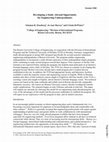
2003 Annual Conference Proceedings
The Boston University College of Engineering, in cooperation with the Division of International P... more The Boston University College of Engineering, in cooperation with the Division of International Programs and the Technical University of Dresden (TUD) in Dresden, Germany, inaugurated a study abroad program in spring 2001 designed specifically for second-semester sophomore engineering undergraduates at Boston University. The program enables engineering undergraduates to incorporate a study abroad experience in their undergraduate degree programs while continuing to make normal progress toward their degrees. Prior exposure or facility with German is not expected before starting the program, but students must participate in an intensive German-language course while in Dresden. The TUD was chosen as a partner in developing this program because Boston University already had a small program and a resident director established at this site. In addition, the TUD had appropriate faculty and laboratory facilities available to teach the requisite science and engineering courses in English. While in Dresden, students take three of four technical courses taught in English by full-time faculty of the TUD, a sociology course also taught in English, and an intensive German language course. The technical courses are based on the same textbooks and syllabi used in Boston and provide comparable laboratory exercises. All courses are Boston University courses, thereby avoiding the transfer credit complications. The semester begins in early February and ends in mid-July. This paper will explain our rationale for choosing this model for an engineering study abroad program, our view of the advantages of this model and the processes undertaken to establish the program. We will report on our experiences with the program to date, and on student outcomes.
Annals of Biomedical Engineering, 2000

The goal of this study is to assess the predictive capacity of computational models of transvenou... more The goal of this study is to assess the predictive capacity of computational models of transvenous defibrillation by comparing the results of patient-specific simulations to clinically determined defibrillation thresholds (DFT). Nine three-dimensional patient-specific models of the thorax and in situ electrodes were created from segmented CT images taken after implantation of the cardioverter-defibrillator. The defibrillation field distribution was computed using the finite volume method. The DFTs were extracted from the calculated field distribution using the 95 % critical mass criterion. The model-predicted DFT energies were well matched to the clinically determined values in four of the nine patients examined (rms difference =1.5 J; correlation coefficient = 0.84). For the remaining five patients the rms difference was 18.4 J with a correlation coefficient of 0.85. Inspection of the weak field distribution revealed that patients with the highest clinical DFT exhibit the most comp...
Proceedings of the Second Joint 24th Annual Conference and the Annual Fall Meeting of the Biomedical Engineering Society] [Engineering in Medicine and Biology
Standard transvenous defibrillation is performed with implantable cardioverter defibrillators (IC... more Standard transvenous defibrillation is performed with implantable cardioverter defibrillators (ICD) using a dual-current pathway. The defibrillation energy is delivered from the right ventricle (RV) electrode to the superior vena cava (SVC) electrode and the ICD metallic housing. Clinical studies of biventricular defibrillation, which uses an additional electrode, placed on the left ventricular (LV) free wall, in conjunction with sequential shocks,
Proceedings of the Second Joint 24th Annual Conference and the Annual Fall Meeting of the Biomedical Engineering Society] [Engineering in Medicine and Biology
The goal of this study is to assess the predictive capacity of computational models of transvenou... more The goal of this study is to assess the predictive capacity of computational models of transvenous defibrillation by comparing the results of patient-specific simulations to clinically determined defibrillation metrics. Solutions for seven patient-specific models have been completed. The 3-D models of the thorax and in situ electrodes were created from segmented CT images taken shortly after implant. Each of the
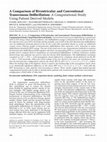
Pacing and Clinical Electrophysiology, 2004
MOCANU, D., ET AL.: A Comparison of Biventricular and Conventional Transvenous Defibrillation: A ... more MOCANU, D., ET AL.: A Comparison of Biventricular and Conventional Transvenous Defibrillation: A Computational Study Using Patient Derived Models. Conventional transvenous defibrillation is performed with an ICD using a dual current pathway. The defibrillation energy is delivered from the RV electrode to the superior vena cava (SVC) electrode and the metallic case (CAN) of the ICD. Biventricular defibrillation uses an additional electrode placed in the LV free wall with sequential shocks to create an additional current vector. Clinical studies of biventricular defibrillation have reported a 45% reduction in mean defibrillation threshold (DFT) energy. The aim of the study was to use computational methods to examine the biventricular defibrillation fields together with their corresponding DFTs in a variety of patient derived models and to compare them to simulations of conventional defibrillation. A library of thoracic models derived from nine patients was used to solve for electric field distributions. The defibrillation waveform consisted of a LV → SVC + CAN monophasic shock followed by a biphasic shock delivered via the RV → SVC + CAN electrodes. When the initial voltage of the two shocks is the same, the simulations show that the biventricular configuration reduces the mean DFT by 46% (3.5 ± 1.3 vs 5.5 ± 2.7 J, P = 0.005). When the leading edge of the biphasic shock is equal to the trailing edge of the monophasic shock, there is no statistically significant difference in the mean DFT (4.9 ± 1.9 vs 5.5 ± 2.7 J, P > 0.05) with the DFT decreasing in some patients and increasing in others. These results suggest that patient-specific computational models may be able to identify those patients who would most benefit from a biventricular configuration.
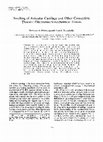
Journal of Orthopaedic Research, 1985
We have measured the relationship between tissue swelling stress and consolidation for bovine art... more We have measured the relationship between tissue swelling stress and consolidation for bovine articular cartilage and corneal stroma in uniaxial confined compression as a function of bath ionic strength. Our experimental protocol and results clearly demonstrate that two concentration-dependent material properties are necessary to describe the chemical dependence of tissue swelling stress in uniaxial compression over the range of deformations and concentrations explored. A general electromechanochemical model for the swelling stress of charged connective tissues is developed. The model focuses on the role of charged matrix macromolecules in determining the mechanical behavior of the tissue. A constitutive relation for the swelling stress in uniaxial confined compression is formulated and the concentration dependence of the material properties of articular cartilage and corneal stroma is determined. The associated free swelling behavior of cartilage and cornea specimens is computed from these results and is found to compare favorably with data from the literature.

Journal of Computational Neuroscience, 2010
Forward solutions with different levels of complexity are employed for localization of current ge... more Forward solutions with different levels of complexity are employed for localization of current generators, which are responsible for the electric and magnetic fields measured from the human brain. The influence of brain anisotropy on the forward solution is poorly understood. The goal of this study is to validate an anisotropic model for the intracranial electric forward solution by comparing with the directly measured 'gold standard'. Dipolar sources are created at known locations in the brain and intracranial electroencephalogram (EEG) is recorded simultaneously. Isotropic models with increasing level of complexity are generated along with anisotropic models based on Diffusion tensor imaging (DTI). A Finite Element Method based forward solution is calculated and validated using the measured data. Major findings are (1) An anisotropic model with a linear scaling between the eigenvalues of the electrical conductivity tensor and water self-diffusion tensor in brain tissue is validated. The greatest improvement was obtained when the stimulation site is close to a region of high anisotropy. The model with a global anisotropic ratio of 10:1 between the eigenvalues (parallel: tangential to the fiber direction) has the worst performance of all the anisotropic models. (2) Inclusion of cerebrospinal fluid as well as brain anisotropy in the forward model is necessary for an accurate description of the electric field inside the skull. The results indicate that an anisotropic model based on the DTI can be constructed non-invasively and shows an improved performance when compared to the isotropic models for the calculation of the intracranial EEG forward solution.
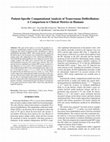
Annals of Biomedical Engineering, 2004
The goal of this study is to assess the predictive capacity of computational models of transvenou... more The goal of this study is to assess the predictive capacity of computational models of transvenous defibrillation by comparing the results of patient-specific simulations to clinical defibrillation thresholds (DFT). Nine patient-specific models of the thorax and in situ electrodes were created from segmented CT images taken after implantation of the cardioverter-defibrillator. The defibrillation field distribution was computed using the finite volume method. The DFTs were extracted from the calculated field distribution using the 95% critical mass criterion. The comparison between simulated and clinical DFT energy resulted in a rms difference of 12.4 J and a 0.05 correlation coefficient (cc). The model-predicted DFTs were well matched to the clinical values in four patients (rms = 1.5 J; cc = 0.84). For the remaining five patients the rms difference was 18.4 J with a cc = 0.85. These results suggest that computational models based soley on the critical mass criterion and a single value of the inexcitability threshold are not able to consistently predict DFTs for individual patients. However, inspection of the weak potential gradient field in all nine patients revealed a relationship between the degree of dispersion of the weak field and the clinical DFT, which may help identify high DFT patients.

Clinics in Endocrinology and Metabolism, 1973
Summary Type III hyperlipoproteinaemia is the only familial hyperlipoproteinaemic state in which ... more Summary Type III hyperlipoproteinaemia is the only familial hyperlipoproteinaemic state in which an abnormal lipoprotein is found in plasma. This very low density lipoprotein is enriched with cholesterol and apoLDL, and impoverished in triglycerides as compared to normal VLDL. Recent studies indicate that it may represent a normal short-living intermediate of VLDL metabolism. Its accumulation in plasma points towards a functional rather than a structural defect in the aetiology of type III hyperlipoproteinaemia. Morphologically, type III is characterised by deposition of lipids in skin, arteries, heart and reticuloendothelial cells, mainly in the form of lipid-laden foam cells. The typical clinical lesions are planar and tuberoeruptive xanthomas, and coronary and peripheral vascular disease. The xanthomas are readily reversible following short of periods of treatment, and there are indications that the vascular lesions are also reversible. This phenomenon may be related to the predominantly cellular nature of lesions in type III. Type III hyperlipoproteinaemia is an easily treatable condition, and plasma lipids can be brought rapidly within the normal limits. Thus, although this s a relatively uncommon lipoprotein disorder, the diagnosis of type III hyperlipoproteinaemia is of great importance to the patient; the results of correct diagnosis and treatment are gratifying.
Biochimica et Biophysica Acta (BBA) - Lipids and Lipid Metabolism, 1972
Biochimica et Biophysica Acta (BBA) - Lipids and Lipid Metabolism, 1973
The relationship of 1251-labelled apoproteins of very low density lipoprotein to that of other li... more The relationship of 1251-labelled apoproteins of very low density lipoprotein to that of other lipoproteins was studied in humans during steady-state conditions and following heparin injection. Heterogeneous metabolism of very low density lipoprotein apoproteins in normal individuals was apparent during steady-state conditions. Radioactivity transferred to high density lipoprotein immediately in viva. With time radioactivity also transferred to an intermediate density lipoprotein (d = ~.oof%~.oIg) and thereafter to low density lipoprotein (d = 1.019-1.063).
Biochimica et Biophysica Acta (BBA) - Lipids and Lipid Metabolism, 1972
Biochim. Biophys. 24cta, 280 (1972) g+Iod APOPROTEIN TRANSFER BETWEEN LIPOPROTEINS 95 specificity... more Biochim. Biophys. 24cta, 280 (1972) g+Iod APOPROTEIN TRANSFER BETWEEN LIPOPROTEINS 95 specificity may not be involved in the simple recombination of apolipoproteins and lipids. These observations may explain the distribution of apoproteins among plasma lipoproteins and provide insight into their metabolic fate.
SPIE Proceedings, 1995
In order to get an understanding of the turbulent air-fuel mixing behavior and the subsequent com... more In order to get an understanding of the turbulent air-fuel mixing behavior and the subsequent combustion process of technically applied spray flames, spontaneous Raman scattering investigations were carried out in the flame of a commercial oil burning furnace. In this furnace a spray of liquid n-heptane is turbulently mixed with air by a swirl generating mixing device. The present geometry
Transactions of the Royal Society of Tropical Medicine and Hygiene, 1968
In these papers there is no record of tick-borne relapsing fever from the city of Jerusalem or it... more In these papers there is no record of tick-borne relapsing fever from the city of Jerusalem or its immediate environs, nor is massive haematuria recorded as a complication in Israel. ADLER et al. (loc. cit.) did record, in one of the medical volunteers who were very closely observed, a slight haematuria with casts that lasted for 3 months. GEFEL et al. (loc. dt.) mention that no haemorrhagic phenomena (epistaxis, haematuria, haematemesis, etc.) were observed in their series of 45 cases. Recently we had the opportunity of observing several cases of tick-borne relapsing fever, contracted in Jerusalem, and in one of them (N.K.) the outstanding clinical feature was massive haematuria. This case is described in detail. Case reports
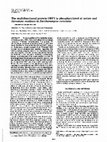
Proceedings of the National Academy of Sciences, 1991
We have purified a DNA replication enhancer-binding protein, OBF1, from yeast cells grown in a me... more We have purified a DNA replication enhancer-binding protein, OBF1, from yeast cells grown in a medium containing 32P-labeled orthophosphate. The purified 32P-labeled protein comigrated on polyacrylamide gels with OBF1 bands identified by immunoblotting with anti-OBF1 antibodies. Furthermore, trypsin treatment of the 32P-labeled OBF1 revealed several phosphorylated peptides, suggesting that OBF1 is multiply phosphorylated in vivo. Incubation of phosphorylated peptides with calf intestinal phosphatase liberated the radiolabel as free phosphate, indicating a phosphoester linkage. Acid hydrolysis of the tryptic peptides revealed 32P-label label comigrating with phosphoserine; some of it, however, was also identified as phosphothreonine. Using anti-OBF1 antibodies, we cloned the OBF1 gene from a lambda gt11 yeast expression library. The DNA sequence of the isolated gene and its over-expression in yeast indicated that OBF1 is identical to ABF-1 and BAF1 proteins, believed to have a role i...







Uploads
Papers by Solomon R Eisenberg